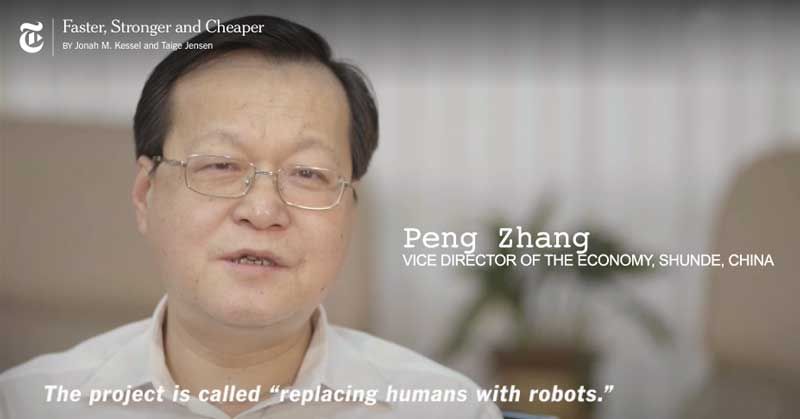
Robohub.org
Video describes accelerating robot deployment in China

In response to rising labor costs combined with a shortage of workers, China has begun to provide incentives to encourage businesses to utilize robots to replace factory workers.
In a video interview for The NY Times, Peng Zhang, Vice Director of the Economy, for Shunde (a city of 2.4 million) in Guandong Province, China, says that he is administering a project to replace humans with robots. Zhang said that the half of Shunde’s population comprised of immigrant workers from other Chinese provinces cannot continue to grow. He cited the following reasons for his actions:
- China’s one-child rules halved the birthrate from 1987 to 2003, consequently China has a continually shrinking supply of workers in the 18-24 age range, the prime age for factory workers.
- Labor shortage is further compounded because potential workers are staying in local schools and universities much longer and, according to the NY Times article, “following a Confucian tradition that the educated do not soil their hands with manual labor, graduates overwhelmingly refuse to accept factory work, except in supervisory, design or engineering positions.”
- Electronics manufacturing is still moving factories to China because most of the parts suppliers are already there; consequently there is much demand for factory work.
- Prospective migrant workers born in the ’80s and ’90s “are inferior to the older generations,” says Zhang in the video. “Their lack of endurance and hard-working spirits” make them less desirable.
Bottom line: As a response to the changing landscape of the labor market, i.e., to compensate for higher wages and harder to find and train labor, several cities and provinces have encouraged robotics be employed in the factories in their districts. Many of Guandong Province’s local authorities, such as those in Shunde, have announced that they are offering various incentive plans to upgrade and adopt robotics into local manufacturers’ factories. Mr. Zhang says in the video that his goal is to reduce Shunde’s workforce by half by using robots and sending the low-skilled migrant workers replaced by the robots back to their home towns.
tags: c-Industrial-Automation, China, cx-Politics-Law-Society, robots and jobs


